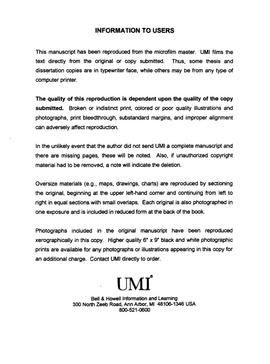| dc.contributor.advisor | Russell, Scott D., | en_US |
| dc.contributor.author | Zhang, Zhaojie. | en_US |
| dc.date.accessioned | 2013-08-16T12:30:35Z | |
| dc.date.available | 2013-08-16T12:30:35Z | |
| dc.date.issued | 1999 | en_US |
| dc.identifier.uri | https://hdl.handle.net/11244/5839 | |
| dc.description.abstract | In Plumbago, the sperm cell that normally fertilizes the egg has a higher calculated charge (8.277 x 103 esu/cm 2) compared with the sperm cell that fuses with the central cell (6.120 x 103 esu/cm2). Microelectrophoresis of tobacco sperm cells was also conducted in this study. It was found that the two sperm cells of tobacco differ in cell size and surface charge. The smaller one (associated with vegetative nucleus, Svn) has an average diameter of 6.73 m m, whereas the larger one (unassociated with vegetative nucleus, S ua) is 7.52 m m. The surface charges for Svn and Sua are 2.94 x 103 +/- 0.17 x 103 esu/cm 2 and 3.03 x 103 +/- 0.17 x 10 3 esu/cm2, respectively. | en_US |
| dc.description.abstract | Immunogold electron microscopy showed that in both Plumbago and Nicotiana, myosin is located on the pollen plasma membrane that surrounds sperm cells, but negligible myosin occurs directly on the sperm plasma membrane. Electrophoretic immunolocalizations corroborate that superficial myosin is negligible on Plumbago sperm cells. When sperm cells of Plumbago are injected into actively streaming Nitella internodal cells, however, they track actin bundles; movement is sensitive to ATP and M2+, indicating the involvement of actomyosin interaction for this movement. Negatively-charged latex beads also move in a similar pattern when injected into Nitella internodal cells. Capillary microelectrophoresis indicates that sperm cells carry a maximum negative charge at pH 7.4. Chemically-fixed sperm cells are weakly positively charged and do not migrate. The negative charge is therefore thought to promote non-specific myosin binding on the sperm cells that causes interactions with actin bands or coronas on the periphery of the egg and central cell that propel sperm to their sites of fusion. | en_US |
| dc.description.abstract | Flowering plant sperm cells are small in size, simple in structure and unlike most sperm in biology, they are non-motile. In the current study, sperm cells of Plumbago zeylanica and Nicotiana tabacum were characterized using light microscopy, immunogold electron microscopy, cell microelectrophoresis, in vitro assays and biochemical assays in order to understand the mechanism of sperm cell transport as well as preferential fertilization in flowering plants. | en_US |
| dc.format.extent | xiii, 95 leaves : | en_US |
| dc.subject | Spermatozoa. | en_US |
| dc.subject | Fertilization of plants. | en_US |
| dc.subject | Biology, Botany. | en_US |
| dc.subject | Biology, Cell. | en_US |
| dc.title | Sperm cell characteristics in relation to its transport during fertilization in Plumbago zeylanica and Nicotiana tabacum. | en_US |
| dc.type | Thesis | en_US |
| dc.thesis.degree | Ph.D. | en_US |
| dc.thesis.degreeDiscipline | Department of Microbiology and Plant Biology | en_US |
| dc.note | Adviser: Scott D. Russell. | en_US |
| dc.note | Source: Dissertation Abstracts International, Volume: 60-06, Section: B, page: 2451. | en_US |
| ou.identifier | (UMI)AAI9934638 | en_US |
| ou.group | College of Arts and Sciences::Department of Microbiology and Plant Biology | |
